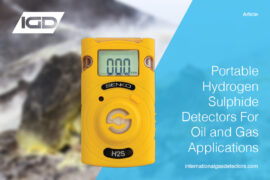Oxygen (O2) depletion monitors are devices capable of measuring the ambient concentration of atmospheric oxygen and signalling when Ievels have fallen. This can enable action to be taken before an evacuation is required and levels become dangerous. In addition to oxygen depletion, problems arise when oxygen levels are too high. This oxygen “enrichment” (levels above 23%) can be dangerous; increasing the chances of combustion and the intensity of fires. In summary, oxygen detectors can signal all dangerous levels of oxygen and are important instruments for a range of applications.
Understanding Oxygen Enrichment & Depletion
In the atmosphere, oxygen is present at around 20.9% (at sea level), with substantial fluctuations either side of that percentage having the potential to cause disaster. Although, it can be misleading to discuss percentages of oxygen without considering atmospheric pressure. For example, atop a mountain where the atmospheric pressure is low there will be less oxygen than at sea level where atmospheric pressure is relatively higher, even though the percentage of oxygen will be the same in both cases. Accordingly, oxygen levels are commonly discussed in reference to partial pressures.

Introducing O2 Depletion Monitors
O2 depletion monitors are recommended in areas where oxygen levels are determined, through a risk assessment, to fall at any point below 19.5% Vol. These include areas where inert or other asphyxiating gases are present or in confined spaces or where significant amounts of carbon dioxide (CO2) are in use. However, it is important to note that when CO2 is suspected of displacing oxygen, CO2 toxicity is a far greater concern and a CO2 monitor should be installed. Nonetheless, O2 depletion monitors are commonly used in research and teaching laboratories and industries that handle nitrogen, helium and argon, such as those involved in manufacturing, food and electronics. Sensors for oxygen detectors are placed in areas at risk and at elevations based on the displacing gases vapour density.

Installing Oxygen Detectors for O2 Depletion Monitoring
Under the conditions described above, installation of O2 depletion monitors is imperative because reductions in ambient oxygen can quickly lead to oxygen starvation, which can impair mental and physical ability and so increase the likelihood of accidents and injuries. Furthermore, significantly low levels of oxygen (12% and lower) can rapidly induce unconsciousness, potentially leading to fatalities. If you are using portable monitors for confined space entry, it is important that battery power has been checked, and the instrument must be in calibration and bump tested before use.
Traditional oxygen sensors use lead-based sensor technology that degrade over time. This leads to a gradual inability for the cell to produce sufficient signal output, which will eventually cause the sensor to drift below the alarm point and trigger. Here, recalibration of the device is a common solution, however, this will only be a temporary fix. To circumvent the issues surrounding lead-based cells, International Gas Detectors Ltd. have developed oxygen detectors based on solid polymer technology. This advanced method is not consumptive and has the added benefit of being RoHS compliant. The sensors offer competent oxygen monitoring with extended lifetimes in excess of 5 years, between 5 and 10 times longer than typical lead-based consumptive sensors. Although seeming purely a product specification benefit, this change has a marked effect upon nuisance alarms and their eradication.
Interested in our oxygen detectors?
Contact a member of the International Gas Detectors team today if you would like to learn more about the applications and specifications of our proprietary O2 depletion monitors. We are always happy to answer any questions and RFQs.





Comment 1
February 11, 2022 at 1:50 pm